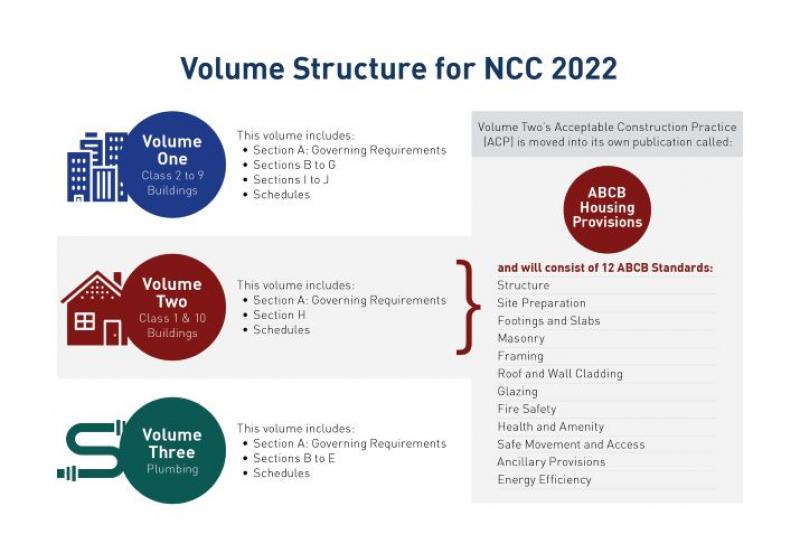As part of the ABCB’s commitment to delivering an NCC that is user-friendly, modern and accessible to practitioners at all experience levels, NCC 2022 comes with some important changes. Here’s what to expect with the code’s new consistent volume structure (CVS).
To support practitioners through these changes, the ABCB has developed a range of resources that explain how and why the NCC is changing, and what it means in practice. Keep an eye out for more detailed materials on each topic in the lead up to the release of the NCC 2022 Public Comment Draft in May 2021.
Why?
As part of the ABCB’s NCC Readability Project, some changes to the code’s structure and format are needed. Amongst other improvements, one the key goals of the next round of NCC reforms is to augment the code’s machine-readability, which opens the door to digital enhancements such as personalised filtering of content. To achieve this, the code must have a consistent structure with information presented in a uniform and predictable way. However, because the NCC has evolved over many years - with volumes drafted in different ways for different purposes - its current structure won’t allow this.
In terms of the history of the code’s clause structure, for what was originally a loose-leaf print publication first released in 1996, NCC Volume Two was purposefully structured very differently to Volumes One and Three. It was developed as a stand-alone ‘housing code’, designed to mostly reflect the on-site building process, and has proven both successful and popular with the housing industry over many years. However, its unique structure also presents a challenge for digitisation, which wasn’t an issue back in 1996, but is a critically important reform for the NCC today.
So to achieve an NCC with a structure that is consistent across all Volumes, yet preserves the approach to Volume Two, the ABCB has developed a new Information Architecture (IA) that will be introduced in NCC 2022.
What is an Information Architecture?
You may have heard of IA before, but if not, a metaphor will go a long way in explaining what it means in this context. IA is to a digital product what a set of house plans are to a builder. It acts like a set of instructions for where everything needs to go and in what order, so things don’t fall apart. Strong IA lays the foundation for the rest of the NCC to be rolled-out in a logical and consistent way, so it can be used and interpreted by as many practitioners as possible (and so software can interpret it too). After all, you can’t build a house without a clear set of plans.
How did we do this?
We began with an analysis of the various parts of the code to understand what could change, without altering the intent of the text in any way. The new IA will have very little impact on Volumes One and Three. The big change will be to Volume Two, where the bulk of Section 3 will be relocated, in its existing order, into its own publication called the ‘ABCB Housing Provisions’. Section 1 will remain unchanged, and Section 2 will form the basis of seven individual Parts which will each contain both Performance Requirements and Deemed-to-Satisfy (DTS) Provisions, just like in Volumes One and Three.
The Housing Provisions will contain the Acceptable Construction Practice (ACP) content of the 12 Parts of Volume Two, Section 3. The twelve Parts will each act as an ABCB Standard, but are compiled into one publication for simplicity. And just like in earlier editions of Volume Two, the Housing Provisions can be divided up as separate standards for the different trades working on-site.
The Acceptable Construction Manual (ACM) content of Volume Two however, will be unchanged. Practitioners will still have the choice of using either the ACM or ACP where both are available, but with a change in terminology. Instead of ACM and ACP, the DTS Provisions in each Part will in most cases simply refer to chapters of the Housing Provisions (ACP) and/or to relevant Australian Standards (or similar) (ACM). And in this way, Volume Two’s DTS clauses are now structured exactly the same way as the rest of the NCC.
So what we’re left with is a Volume Two which is much smaller, but with much more targeted content. The diagram shows the reorganised NCC Volumes.

So while your new NCC may look a bit different at first, the new IA and CVS ensure that the NCC is organised in a much more logical and practical way, with Volumes that are tailored towards the particular sectors. For example, if you’re a domestic builder, it’s likely you will only need to refer to Volume Two.
This means the NCC will be easier to read, understand and reference, leading to greater adoption across industry. It also means new entrants to the building and plumbing industries only have to learn a single volume structure, and of course, it will be machine-readable.
What’s next?
What about the rest of the changes, you might ask? Check out our other articles and resources for more information on the key changes to NCC 2022. If you have any questions, please get in touch with us at NCCOnline-feedback@abcb.gov.au.